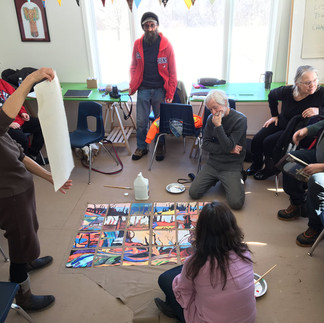YOU ARE NOT ALONE 4/27/2022

“It’s important to understand that if you have values that include community and people, and you want your neighbour to live in dignity and with respect, and if you’re feeling the heaviness and the weight of the pandemic, then I think you should presume you are feeling moral distress. You should take the time to think about yourself and how you’re feeling.”
-Beth Sheffield, Developmental Services Facilitator and Green Wood Coalition founding member
AT SOME POINT over the last two years it all may have started to feel like too much. Heaviness, is how Beth Sheffield, a Developmental Services Facilitator and Durham College teacher, describes it. Then, in the course of recent mental health training, she learned its name: Moral Distress.
Moral distress is a feeling of exhaustion, sadness or anxiety arising when you see something that is wrong but are powerless to fix it. First documented in nurses in the 1980s, it was later broadened to include anyone working in caregiving. Its relevance today to COVID-19 and what many of us are feeling is inescapable.
Consider what we’ve learned about the inequities the pandemic exposed -- how those who are homeless, experiencing food insecurity or living with mental and physical disability suffered disproportionately, how access to social and health supports was severely curtailed and how inadequately funded nursing homes proved fatal to our elderly, as sons and daughters looked on helplessly. Is it any wonder we feel moral distress?
Add to this the endless media bombardment of how bad things were as we sat at home, forced to surrender activities and volunteer roles that gave meaning and purpose to our lives.
In an essay circulated this month to 3500 Christian Horizons employees reflecting on the pandemic, Beth writes, “It is almost as if this virus has been designed to separate us from each other.”
As a founder of Green Wood Coalition whose lifelong commitment, with husband, David, has been to work for inclusion, social connection and every person’s right to live in dignity, Beth shared her reflections on moral distress and where we will find hope.

Green Wood: You work with staff who support people in independent living settings. How would you describe the moral distress these workers experienced?
Beth Sheffield: In my essay, I explain this: As an organization, we believe in the dignity and worth of every person, regardless of intellectual or physical disability. We demonstrate that worth by working tirelessly in our communities to support people in the pursuit of inclusion, whether by going to the neighbourhood coffee shop each week, where the person is known by name, supporting a person in pursuit of their employment goals, or helping someone connect to family they did not know they had. None of this has been possible during the pandemic, so the depth of grief and sadness we feel should almost be an expected outcome.
Green Wood: You spent the past year conducting interviews -- 137 in all -- with staff and those they support about the pandemic’s impact. How would you summarize what you learned?
Beth Sheffield: This has been a very difficult time for people with intellectual or developmental disabilities. They were grouped with long-term care and presumed to be at great risk, so super sad things happened, like people were made to give up their paper routes -- of course, with the best of intentions to keep them safe -- but its just so hard. Now, when restrictions are lifting, those routes are no longer available. Or people who swam three times a week were told the pool is closed so they were unable to have any physical activity over this entire time and will never gain that strength back. To hear these stories of great sadness from people or their loved ones has been so heavy, but I also feel honoured.
Green Wood: Given what you’ve seen among frontline workers, is it legitimate to presume others, on the fringes, could experience moral distress?
Beth Sheffield: Yes. If we believe in community then, absolutely, every one of us should be having this struggle and feeling this distress. Of course, there may be different levels, but I think it’s all of us. If we care about our neighbour, then we are going to feel it. Giving words to it has helped me to process and think through it, to know that I’m not alone in this discomfort and that we have hope for better days ahead.
Green Wood: Organizations like Green Wood had hundreds of volunteers when the pandemic struck -- people who cooked for community dinners or helped with programs. As these roles were taken from them, they sat at home, seeing a need they could not help to fill. What would you say to them?
Beth Sheffield: The first thing to understand is that you are not alone in feeling this sadness and sorrowfulness. It will take time for us to heal again. This has been a long journey. So whether it’s children who are behind in where they should or could be, whether they’ve just not had opportunities their siblings have had to go on class trips or to see their teacher’s face, or for the students I teach at Durham College who are graduating and, potentially, in the face-to-face role of support worker who have never been face to face, I think it’s all of us. You should take time to think about yourself and how you’re feeling. Practise self care, go for a walk, get some fresh air, try to sleep at night, try to eat nutritious food. When we take care of our bodies it really does help our mental and emotional health.
Healing resources are available at the following links:
STILL IMAGINING 4/13/2022

This wonderful image takes us back to some memorable times that we've shared as a community around IMAGINATE conferences and 'evenings of possibility'. While that kind of in-person human experience hasn't been possible for the past couple of years, we are planning some exciting gatherings and are making plans for IMAGINATE 2023. [This evocative painting created by artist, Mique Michele, is now on display at our Community Hive in Port Hope.]

.png)





























